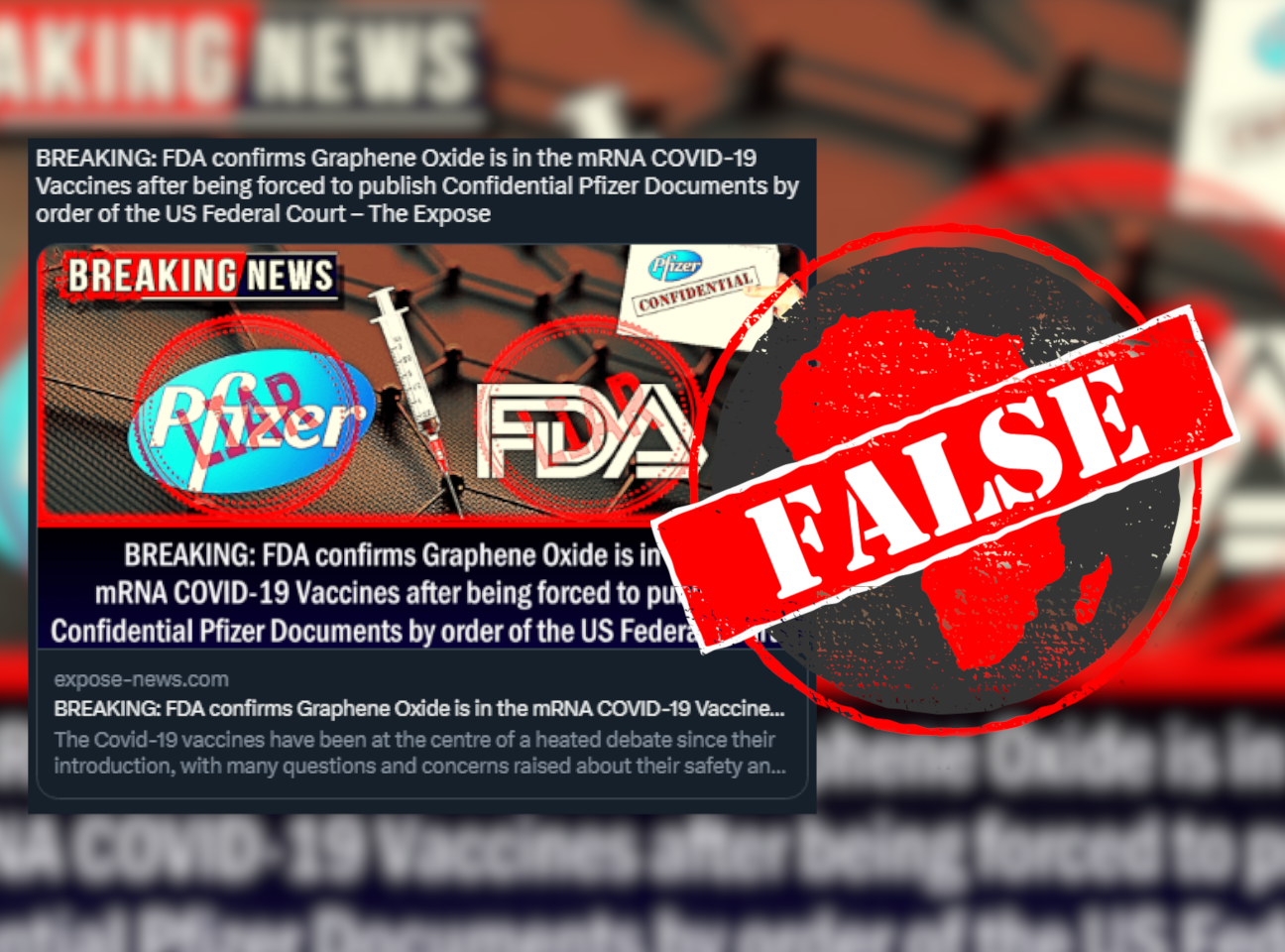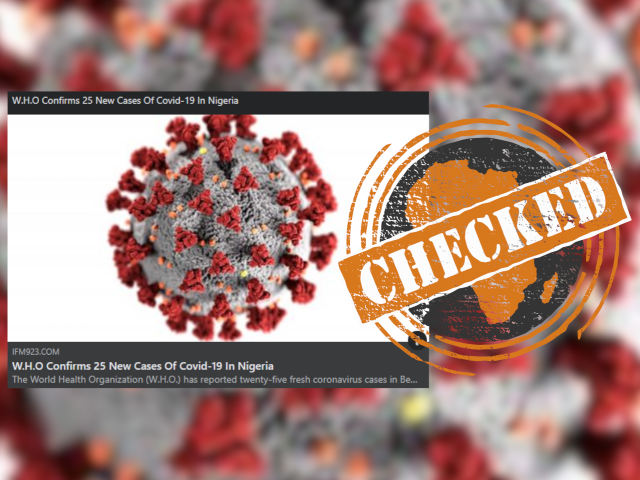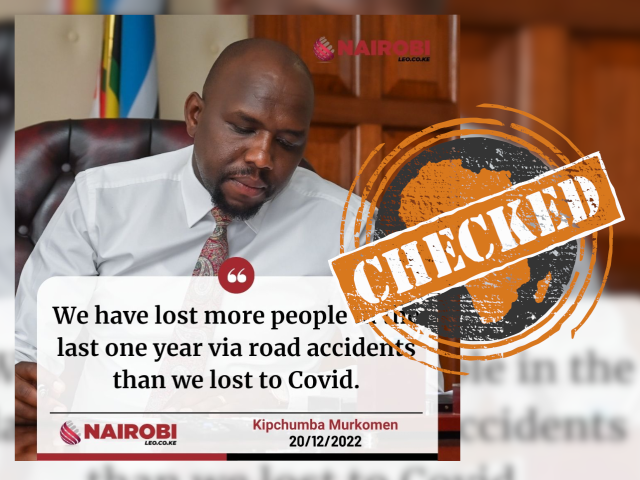IN SHORT: We’ve seen many false and misleading claims about Covid-19 and the vaccines to prevent it since the start of 2020. The latest rumour about a vaccine ingredient, spreading in April 2023, also reveals a misunderstanding.
A Twitter user with over 26,200 followers has shared a link with a worrying headline. It’s been viewed nearly 300,000 times.
It reads: “FDA confirms Graphene Oxide is in the mRNA COVID-19 Vaccines after being forced to publish Confidential Pfizer Documents by order of the US Federal Court.”
The link is to an article published on The Exposé on 2 April 2023. This is a website known for publishing misinformation, some of which Africa Check has previously debunked.
The Exposé also tweeted the link. It was also shared on Twitter here, here, here, here and here, and by these Twitter accounts with large numbers of followers.
Another tweet makes an almost identical claim: “The FDA has confirmed that blood clot causing, Graphene Oxide, is in the mRNA Covid vaccines, according to recently published confidential Pfizer documents.”
Africa Check has debunked numerous false claims about the Covid-19 vaccine, including that it includes ingredients such as mercury and aluminium, and even monkeypox.
But did the US Food and Drug Administration (FDA) confirm that graphene oxide is an ingredient in the mRNA Covid-19 vaccine “after being forced to publish confidential Pfizer documents”?
We checked.

Graphene oxide not on list of ingredients in mRNA vaccines
Covid-19 mRNA vaccines help your body recognise and fight the virus by instructing your cells to mimic a SARS-CoV-2 coronavirus spike protein.
The other ingredients in mRNA vaccines are fats, to protect the mRNA, salts and a small amount of sugar.
Graphene oxide is not listed as an ingredient in the Pfizer mRNA Covid-19 vaccine, or any other Covid-19 vaccine.
Graphene is a single layer of carbon atoms forming a hexagonal structure. Graphene oxide is oxidised graphene and has applications in biotechnology, medicine and cellular imaging.
Claim comes from misunderstanding of a Pfizer document
The Exposé article speaks about a document of “a study carried out by Pfizer between April 7th 2020 and 19th August 2020”. It says that the study was conducted to “determine how the vaccine works”.
This is a real study, titled Structural and Biophysical Characterization of SARS-CoV-2 Spike Glycoprotein (P2 S) as a Vaccine Antigen, and published by Pfizer in December 2020.
The Pfizer study’s purpose was to characterise the vaccine antigen encoded by the company’s mRNA vaccine BNT162b2 .
The Exposé article includes a screenshot of a paragraph on page 7 of the study, with the words “overlaid with graphene oxide” highlighted. It claims this is proof that the chemical compound is an ingredient in the vaccine.
But this has been taken out of context.
The graphene oxide mentioned in the study was used during a microscopic process to help examine the structure of the protein in the vaccine.
In an email to AP News, Dr Matthew Laurens, a researcher at the University of Maryland School of Medicine’s Center for Vaccine Development, confirmed this.
The lab study was done to see whether the spike protein authentically mimicked the actual spike protein of the coronavirus, Laurens told AP News.
FDA confirms on Twitter that graphene oxide is not a Covid-19 vaccine ingredient
The FDA responded to one of the tweets making this claim on Twitter and confirmed that graphene oxide is not an ingredient in Covid-19 vaccines.
BREAKING: The FDA has confirmed that blood clot causing, Graphene Oxide, is in the mRNA Covid vaccines, according to recently published confidential Pfizer documents.
— Pat Brody (@PATBR0DY) April 11, 2023
The federal agency also confirmed that graphene oxide was used as a material to aid in the imaging of the protein in the mRNA vaccines.
“Graphene oxide is included in a sentence on page 7 to describe, in part, the lab procedure pertaining to the study of the structural characterization of the SARS-CoV-2 spike protein using a specific type of microscope. Graphene oxide is a material to aid in the protein imaging.”
“In short, that document doesn't say what you think it does,” the FDA tweeted.
As so often before, since the start of the Covid-19 pandemic, a small piece of information has been taken out of context to make an outlandish – and untrue – claim.
Republish our content for free
For publishers: what to do if your post is rated false
A fact-checker has rated your Facebook or Instagram post as “false”, “altered”, “partly false” or “missing context”. This could have serious consequences. What do you do?
Click on our guide for the steps you should follow.
Publishers guideAfrica Check teams up with Facebook
Africa Check is a partner in Meta's third-party fact-checking programme to help stop the spread of false information on social media.
The content we rate as “false” will be downgraded on Facebook and Instagram. This means fewer people will see it.
You can also help identify false information on Facebook. This guide explains how.





Add new comment